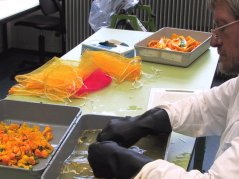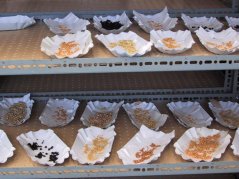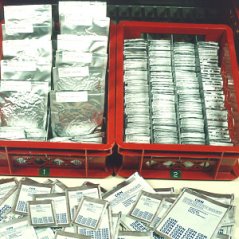
CGN seed cleaning, drying and packaging procedures
Sample quantity and quality and viability
When seed samples enter the storage facilities, the seed quantity will first be determined. A sample must contain a minimum amount of seeds, this differs per crop. The upper limit is usually the quantity of seeds that can be stored in the largest pre-fabricated sample bags (volume ±500 cm3). The purity of the sample is checked visually and if necessary the sample is cleaned. Criteria for purity are: absence of dust particles and broken or empty seeds.
Sample viability is determined in germination tests. Random samples of usually about 200 seeds are tested. In the case of some wild species smaller seed samples are tested. The tests are in compliance with the ISTA rules, which describe standard tests per crop. The germination tests are executed by CGN.
In general the germination percentage should be at least 80% for varieties and landraces and 60% for wild species if samples are to be included in the collection. If material is difficult to regenerate, e.g. because of climatic constraints, acceptable levels of germination percentages may be lower. If the germination percentage does not meet the criteria, the sample needs to be regenerated again.
Seed cleaning
After harvesting, the bagged and labelled samples are preliminary dried in an oasthouse and later in a climate chamber at 15°C and 30% RH. Dried samples are threshed using a small winnowing machine (Clipper). Seeds and debris are separated using differences in seed size, specific gravity and floating speed by passing the sample through a combination of different sieves (round or slit sieves) and air flow devices. Since the material to be processed is often very heterogeneous, manual adjustment of sieves and airflow current is necessary. After each sample is processed, the winnowing machine is cleaned using a high pressured airstream. Peas and beans are threshed by hand, since mechanical threshing would damage the seeds.

After threshing, the seeds are separated by shape and size using indented cylinders. To maintain sample variation, cleaning procedures should not be too discriminative. During cleaning, operators check visually for damaged seeds.
Some of the horticultural crops are pre-cleaned at a different location. After harvest the seeds are bagged, thereafter the labeled samples are dried in an oasthouse at 25°C and uncontrolled humidity for 4-5 days. All samples are cleaned manually. First of all the bagged samples are crushed by hand to separate the seeds from the remaining parts of the inflorescence. The samples are then cleaned, using sieves in airflow cabinets and/ or an electric blower. For the fruit vegetables the seed cleaning procedure differs considerably. Tomato fruits are cut in halves and the seeds with fruit juice are transferred to cups and diluted with an equal amount of 2% HCL solution to remove the slime. For cucumber and melon a 4% HCL solution is used, mixed with an equal amount of water. After 1 hour the seeds are washed in a sieve with water, and dried on filter paper at room temperature. Pepper fruits are cut in halves, the seeds are removed from the placenta and washed in water. Good seeds sink, the rest of the seeds are removed. The seeds are dried on filter paper at room temperature. For small peppers squeezing the fruits in water works more efficient. The seeds can then easily be removed. Eggplant fruits are broken in pieces and crushed with a PVC pounder. After crushing the pulp is mixed with water. The seeds settle down and the pulp is poured off. Seeds are washed and dried on filter paper at room temperature. The potato fruits are squeezed by hand under water. Empty seeds and contamination are removed by running tap water. The seeds are dried on filter paper.
After cleaning, the samples are checked visually for purity and damaged seeds. Before samples are transferred to the drying room, they are checked with reference samples (especially the wild species) or reference data for matching seed colour and shape. The labels on the outside of the bags are also checked to see that they correspond with the labels inside the bag. As a final check, the seed quantity is checked before transferring the material to the seed manager for further processing.
Seed drying

The seed samples are dried in the drying room at 15°C and 15% RH, until a seed moisture content of 3-7% is reached. Depending on initial moisture content and the physical and chemical properties of the seed, it takes 2 to 8 weeks before the desired percentage seed moisture content is reached. During drying the seed samples are packed in paper or jute bags. Large samples are divided between several bags to expedite drying.
Seed packaging
The seed samples are packed in laminated aluminium foil bags. The bags consists of 3 layers: the inner layer of 80 µm polyethylene, an intermediate layer of 12 µm aluminum foil and an outer layer of 12 µm polyester. Polyethylene is necessary to seal the bags, the aluminium is non-permeable to moisture and the polyester is used to give the bag its mechanical strength. Four different sizes of bags are used, depending on the crop and the size of the seed samples. For spiny spinach seeds cardboard layers are used to prevent puncturing of the seedbags.
Five different types of samples for storage are distinguished:
- User samples (small quantity that is distributed to users)
- Germination samples, sample containing seeds that are used to monitor the viability of the accession (prior to storage and at intervals during storage)
- Regeneration sample (sample that is used for regeneration of the accession in case the seed quantity or quality is below acceptable levels)
- Duplication sample. A sample that is shipped to another genebank or the Svalbard Global Seed Vault for safety duplication.
- Residual sample (sample containing the remaining seed of the sample)
Each accession has at least one sample for duplication, one for regeneration and four samples for germination tests. There is usually one residual sample. Sometimes when the seeds are very large, two residual samples are made. Depending on the expected demand by users, the number of pre-packed user samples varies per crop from four to eight bags. Pre-packing of user samples is considered to be more efficient and avoids repeated exposure of seeds to extreme changes in ambient temperature during storage.
| Crop | User | Germination | Regeneration |
|---|---|---|---|
| Asparagus | 100 | 100 | 200 |
| Barley | 25/50/100 * | 100 | 100/200/400 * |
| Clover | 200 | 100 | 400 |
| Cocksfoot | 200 | 100 | 400 |
| Cucumber | 25 | 100 | 50 |
| Melon | 25 | 100 | 50 |
| Eggplant | 25 | 100 | 50 |
| Faba beans | 40 | 100 | 200 |
| Festuca | 200 | 100 | 400 |
| Flax | 300/50* | 100 | 4000/100* |
| Lettuce | 100/50* | 100 | 100 |
| Lupin | 40 | 100 | 200 |
| Maize | 100 | 100 | 400 |
| Miscellaneous crucifers | 100/300* | 100 | 300 |
| Oats | 25/100 * | 100 | 100/400 * |
| Onion and leek | 100/300 * | 100 | 300 |
| Peas | 40 | 100 | 200 |
| Pepper | 25 | 100 | 50 |
| Poa | 100 | 100 | 200 |
| Potato | 50 | 100 | 100 |
| Rye-grass | 200 | 100 | 400 |
| Spinach | 100/200* | 100 | 200/400 |
| Tomato | 25 | 100 | 50 |
| Timothy | 200 | 100 | 400 |
| Wheat | 25/50/100 * | 100 | 100/200/400 * |
* Number of seeds depends on the subcrop type
Table updated (9 February 2021)
Before packing, the seed quantities of large seeded crops are subdivided into smaller parts using an INRA Rifle type Divider. To check the correct number of seeds per sample, a Contador seed counter is used. Finally the weight of the residual sample is recorded.
After the samples of different sizes are prepared, they are bagged, and sealed under light vacuum conditions using the Hencovax 1900/2 vacuum-sealing machine. Vacuum sealing provides a check on air-tightness of the laminated foil bags. The strength of the vacuum pump can be adjusted, since it is important not to use too high vacuum conditions as this might cause damage to the packing material and/or to the packaged seeds. Especially sharp and pointed seeds may puncture the packing material if not properly treated. After the samples are sealed, the bags are labeled. The label contains the following information:
- Accession number
- Crop name
- Scientific species name
- Variety or other name
- Date the sample was made
- Type of sample (user, germination, multiplication, duplication or residual sample)
- Year of regeneration
- Number of regeneration cycles
- A barcode as a unique identifier for the bag containing some of the above information
The labels are printed on a thermal transfer printer (Easy Coder 7421). To ensure a permanent bond in the -20°C environment; special glue is used to stick the labels to the seed bags.
Seed storage
CGN has long- and medium-term storage facilities, both at -20°C. The total seed bulk after regeneration of an accession is split into two parts. The user bags are placed in household freezers at -20°C. These bags can be easily accessed. The bags of the other types (regeneration bags, germination bags and rest bags) are placed in a cold store at -20°C.
The numbered boxes are grouped by crop and placed on numbered shelves in the cold store. The location of storage (box and shelve) is recorded per bag in the information system.

Monitoring accessions
Quantity
Regularly accessions with no user samples are marked. New user samples have to be packed using the residual sample. This sample is transferred from the cold store at -20°C to +4°C, one day in advance, to prevent condensation on the seeds. Then the sample is moved to the seed laboratory (±20°C) to make new user samples to be stored in the freezers.
Viability
Accessions need to be regularly tested for viability, this is monitored with standard germination tests. The interval for viability checking depends on the expected seed-storage life of the crop. Crops with a short storage-life need to be checked more frequently than crops with a long storage life. The complete lettuce collection is subject to viability checking every 10 years, whereas the cereal collection is checked every 10, 20, 30 years respectively dependent of the initial germination score. The germination tests are executed by CGN according to the ISTA rules.